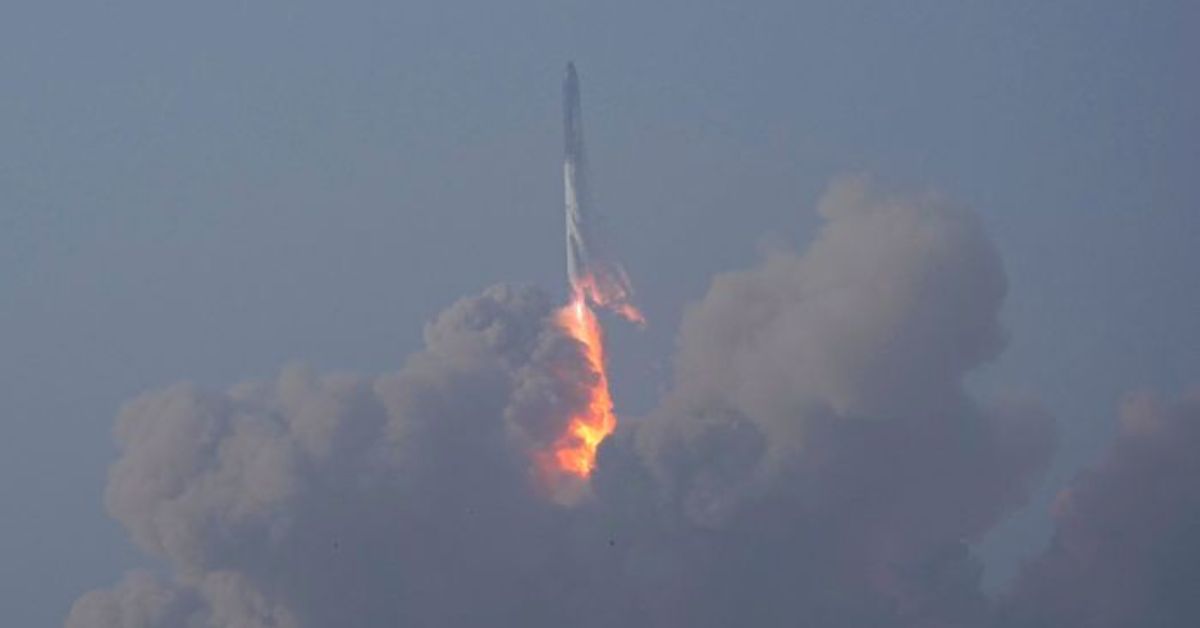The largest and most powerful rocket ever built took off from Texas but exploded within minutes in a test mission that SpaceX hopes will be the first step on a human journey to Mars.
After a cancelled launch earlier this week because of a pressurisation issue, the 120-metre Starship rocket system took off at 8.33am local time (2.33pm in the UK) on Thursday. It gathered speed, but then started to spin at altitude before exploding about four minutes after leaving the ground.
It appeared that the two sections of the rocket system – the booster and cruise vessel – were unable to separate properly after takeoff, possibly causing the spacecraft to fail. It was not immediately clear whether the rocket exploded spontaneously or if the Flight Termination System was activated – a failsafe that destroys the spacecraft to prevent it from veering too far off course.
SpaceX had previously warned that the chances of success were slim, and that the purpose of the test flight was to collect data regardless of whether the full mission was completed. Even after the rocket disintegrated, SpaceX employees cheered.
“As if the flight test was not exciting enough, Starship experienced a rapid unscheduled disassembly before stage separation,” SpaceX said in a statement on Twitter, referring to the explosion.
As if the flight test was not exciting enough, Starship experienced a rapid unscheduled disassembly before stage separation
— SpaceX (@SpaceX) April 20, 2023
The uncrewed sub-orbital test marked the first “fully stacked” trial in which the Starship cruise vessel – which is designed to eventually carry up to 100 astronauts – was placed on top of the Super Heavy booster rocket, whose 33 Raptor engines provided the immense thrust needed.
Almost as long as three passenger jets, the mammoth spacecraft stands 10 metres taller than the Saturn V rocket that sent humans to the moon in 1969.

Elon Musk, the founder of SpaceX, gained the necessary approval last week from the Federal Aviation Administration for the launch to go ahead.
The upper and lower components of the system are designed to power themselves back to Earth for a soft landing and reuse. Musk claims that the reusability of rockets makes space travel substantially less expensive than what Nasa could offer.
Unlike NASA, which seeks to avoid risk, SpaceX has a track record of allowing test flights to explode, with Musk claiming that the private company benefits from understanding what goes wrong. To launch its rockets, SpaceX developed its own spaceport, Starbase, on the Gulf of Mexico in Boca Chica, Texas. Several additional Starships are already being built in preparation for future tests.
Musk said he developed Starship, previously named the BFR (heavily hinted to mean Big Fucking Rocket), so that humans can eventually become an interplanetary species. To do this, he intends to begin the colonisation of Mars, which he said is needed to preserve humanity in case a planet-destroying event, such as nuclear war or an asteroid strike, wipes out life on Earth.
SpaceX believes that Starship, which can carry up to 150 tons of payload, will be able to transport dozens of people on long-duration interplanetary trips. It already has a privately sponsored journey to the moon for 11 people planned for this year, though that timeline now appears implausible.
As part of its Artemis program, Nasa has also contracted SpaceX to land people, including the first woman, on the moon as early as 2025. That deadline is likewise thought to be unduly ambitious.
The company has announced longer-term plans to use the spacecraft as a shuttle for commercial travel on Earth, promising trips from London to Tokyo in under an hour.
Til Then, keep yourself updated with all the latest news from our website nogmagazine.com.